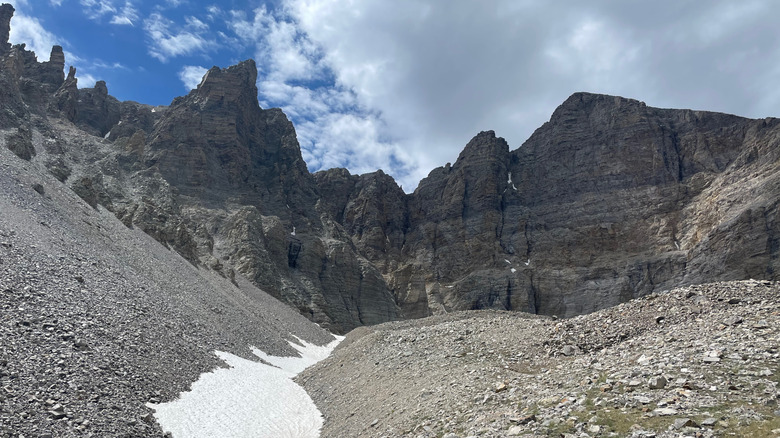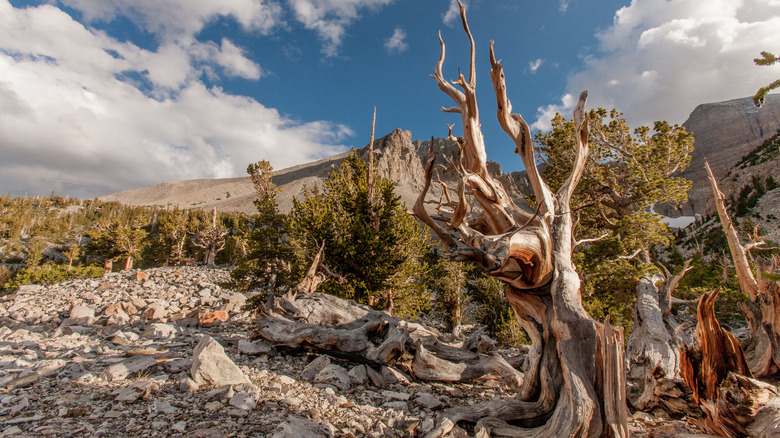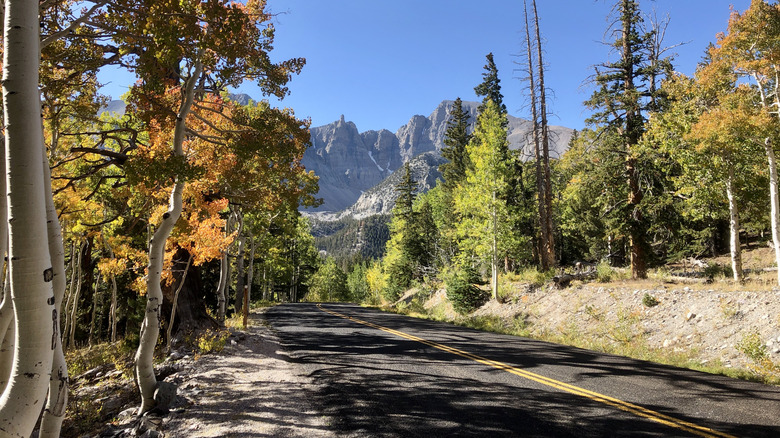Nevada's One And Only Glacier Thrives On This Wild Great Basin National Park Trail Through Ancient Forests
You might not immediately associate Nevada with ancient glaciers, yet 77,180-acre Great Basin National Park is home to the state's only glacier, a relic dating back to the last glacial period. Due to the effects of climate change, the Wheeler Peak Glacier has become a shadow of its former self. Yet, it's still a fascinating sight to behold in one of the United States' four major deserts, albeit a high-altitude desert where the tiny bit of annual precipitation mostly comes in the form of snow.
Small in comparison to this secret Alaskan glacier that's deeper than the Grand Canyon, the Wheeler Peak Glacier covers only 2 acres, and is shrinking every year. It's an unfortunate truth that this ancient glacier simply won't exist in 50 or possibly even just 20 years. Perched at 11,500 feet, it's made primarily of ice, mud, and rock –– materials strong enough to carve out its massive glacial valley.
However, what makes this fading glacier even more special is the trail leading to its location at the base of imposing Wheeler Peak. The 4.8-mile trail winds through a hauntingly beautiful forest of ancient bristlecone pines, some over 3,000 years old. Their bare, gnarled branches twist towards the sky, a reminder that although they look dead, they are very much alive and belong to the oldest living tree species on Earth. Visitors can extend their hike to the nearby alpine lakes, including Stella Lake and Teresa Lake, for the ultimate getaway at Great Basin National Park.
How to hike to the Wheeler Peak Glacier
The Wheeler Peak Scenic Drive offers the chance to view the glacier from the Wheeler Peak Overlook — there's even a telescope — but the best way to experience this land formation is by hiking the Glacier Trail. Because this path overlaps other trails, you'll want to start from the Bristlecone Trailhead, referred to as the Bristlecone, Alpine Lake and Sky Island Forest Trailhead on Google Maps, and follow signs for "Rock Glacier."
The trailhead is located at the end of Wheeler Peak Scenic Drive, so it's hard to miss. However, you should pick up a trail map at the visitor center before starting your hike. After trekking 1.4 miles, you'll reach a short and oh-so-worth-it detour to the Wheeler Peak Bristlecone Pine Grove. Here, you'll find an otherworldly stand of bristlecones, both ancient and comparatively young, growing from the impossibly rocky ground. Take a minute to read the interpretive plaques before continuing to the boulder field in front of the glacier.
Depending on the time of year, the glacier may be covered in snow, but it looks like a cluster of slightly darker rocks at the base of sheer cliffs. If you live near sea level, you might experience altitude sickness. After all, the trail starts at 9,890 feet and gains over 1,000 feet in elevation. One of the best things to do when you experience altitude sickness on a hike is to make sure you are staying well hydrated.
Planning your visit to the Wheeler Peak Glacier
The best time to visit is in the late fall, after the snow has already melted, and you can actually see the glacier. For incredible stargazing and ultra-dark and clear night skies certified by the International Dark Sky Association, plan your trip to coincide with the new moon. The park also offers ranger-led astronomy programs during the summer months—check the event calendar on the National Parks Service website for more information.
There are no hotels or lodges in the park, but the Wheeler Peak Campground is steps from the Bristlecone Trailhead. Shaded by aspen trees, the sites are primitive—no electricity, flush toilets, campstore, or drinking water — but the mountain vistas are unbeatable. This campground can get quite chilly at night, so keep alternative options in mind, such as the Upper and Lower Lehman Creek Campgrounds or Ely, a unique wild West town that's the best gateway to Great Basin National Park.
One of the only drawbacks of planning a trip to the park is its remote location. Las Vegas is about five hours south, while the nearest major airport is 3.5 hours away in Salt Lake City, Utah. Regardless of your starting point, make sure to fill up your gas tank before entering the park and don't rely on cell phone service or GPS navigation while inside.


